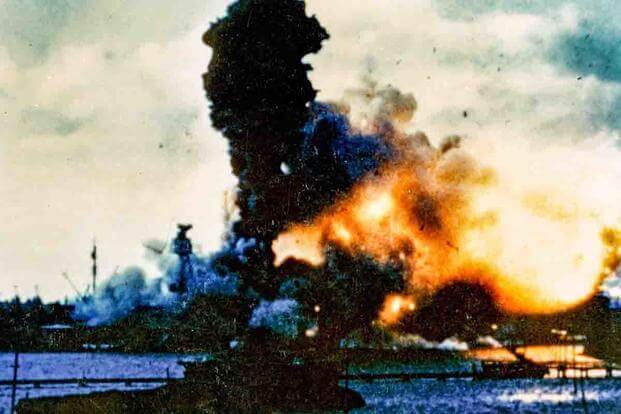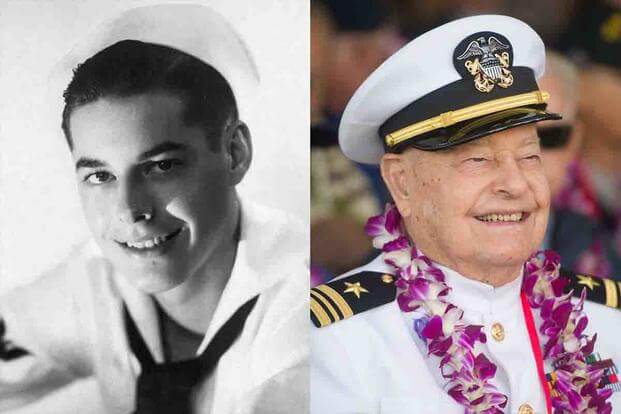Of the U.S. Navy warships lost or damaged during the Japanese surprise attack on Pearl Harbor, the hardest hit was by far the USS Arizona, which was struck by four armor-piercing bombs. One of those bombs blew up the ship’s magazine, causing an explosion which sank the Pennsylvania-class battleship and killed 1,177 sailors and Marines, hundreds of whom are still entombed there to this day.
Among the survivors of the explosion was 20-year-old Lou Conter, a quartermaster who was standing on the Arizona’s quarterdeck at 7:55 a.m. when the first wave of 138 Japanese airplanes launched their surprise assault. Conter not only survived the explosion of the ship’s magazine, but he survived the attack on Pearl Harbor and the rest of World War II.
Conter died of congestive heart failure more than eight decades later on April 1, 2024, at his home in Grass Valley, California, at age 102.

Conter was born Sept. 13, 1921 in Ojibwa, Wisconsin, enlisting in the Navy when he turned 18 in 1939. After three months of boot camp in San Diego, he was sent to the USS Arizona as a regular deckhand on the forward port side of the ship. After making Seaman 2nd Class, he was transferred to the quartermaster division. The attack on Pearl Harbor occurred just over a year later.
“The first planes came over at five minutes ‘til eight, as the color guard was ready to play colors,” Conter told the Library of Congress Veterans History Project. “We took a few bomb hits and the captain [Franklin Van Valkenburgh] came up immediately and said to secure the quarterdeck.”
Within minutes of the attack, both Capt. Van Valkenburgh and Adm. Isaac C. Kidd were on the bridge with other members of the quarterdeck crew. The ship had been cleared of its lines and gangplanks and was ready to get underway. But after two enemy hits, a Japanese bomb penetrated the Arizona’s deck and blew up the ship’s magazine, which held one million pounds of gunpowder. The explosion lifted the more than 35,000-ton battleship some 30-40 feet out of the water and ignited a fire from the mainmast forward.
“Guys were running out of the fire and trying to jump over the sides,” Conter recalled. “Oil all over the sea was burning… our senior officer ordered all us survivors to take them in and even render them unconscious if we had to, and lay them down on the deck so they wouldn’t jump over the side and kill themselves.”
Conter began helping his fellow crew members and preparing to move casualties to the hospital, but water began flowing over the deck as the Arizona started to sink. It wasn’t long before he was ordered to abandon ship. Once in the lifeboats, the sailors began pulling bodies out of the water and fighting fires. That work continued until the following Tuesday; the Navy was forced to call off the diving operation five days later.
Conter was one of 335 sailors and Marines to survive the attack, and was the last living survivor. Some 2,341 service members died on Dec. 7, 1941.
Conter continued serving in the Navy after Pearl Harbor. He became a naval aviator, piloting PBY-1 Flying Boats for Patrol Bombing Squadron 11, a “Black Cat” unit, hunting Japanese submarines at night while painted black. He flew 200 missions in the Pacific Theater where he was shot down twice, both time rowing to safety aboard a raft. After the war, he joined the reserve and went home to California.
During the Korean War, Conter reentered active duty, serving as an air intelligence officer and flying missions from the Essex-class aircraft carrier USS Bonhomme Richard between May and December 1951. When he returned to the United States, he was sent to work in special operations for the National Intelligence Department. There, he established the Navy’s first Survival, Evasion, Resistance, and Escape, or SERE, training program and became the service’s first SERE officer.
Conter would start SERE schools across the United States and in Germany, training aviators who would use the training in the Vietnam War. He eventually retired in 1967 as a lieutenant commander, having served 28 years in the Navy. He became the last survivor of the USS Arizona after Ken Potts died in April 2023 at age 102.
That same year, at age 101, Conter told the Wall Street Journal he would have liked to go visit the USS Arizona Memorial one last time. He hadn’t been since 2019, but his doctor forbade him from taking the nine-hour flight; during that visit, he noted how much he enjoyed visiting his shipmates. Though many consider him and every member of the Arizona’s crew as heroes, Conter refused to use that label.
“I consider the heroes the ones that gave their lives, that never came home to their families,” he said. “They’re the real heroes.”
Want to Learn More About Military Life?
Whether you're thinking of joining the military, looking for post-military careers or keeping up with military life and benefits, Military.com has you covered. Subscribe to Military.com to have military news, updates and resources delivered directly to your inbox.















